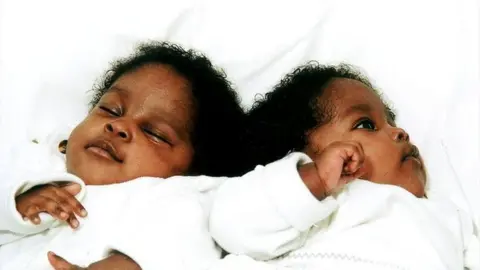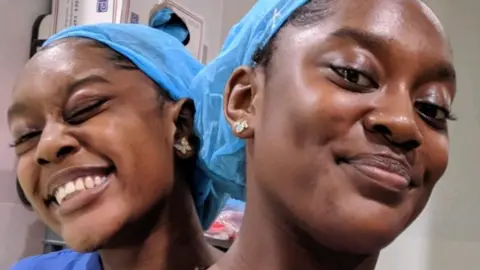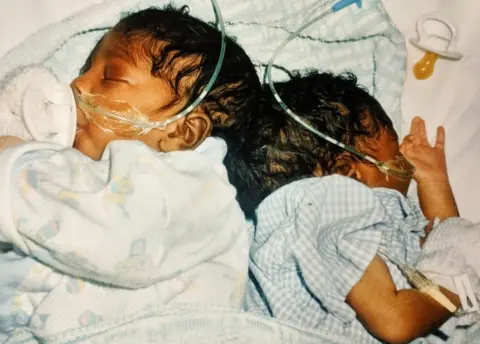Conjoined twins: 'We always knew we were different'
 Mowatt family
Mowatt familyIn December 2001, a perilous operation took place in Birmingham to separate three-month-old conjoined twins, Sanchia and Eman Mowatt. They started life in the full focus of the world's media, such was the rarity of their predicament. What are the 19-year-old sisters who defied the medical odds doing today?
There was, medics said, a "slight judder" felt in the operating theatre, and a cheer erupted in the room. At the end of the painstaking 16-hour procedure, the two little girls were separated. They had spent their first three months attached at the spine.
It was a remarkable day at Birmingham Children's Hospital - the first time such an operation had been carried out in the UK, and only the third time in the world.
It was also extremely high risk - the survival rate for separated conjoined twins is between 5 and 25%. Even if they had come through the surgery, one or both of the girls could have been paralysed as neurosurgeons meticulously separated their spines.
But, joyously, the operation was a complete success. Sanchia and Eman's elated and relieved parents Emma and David could finally hold one daughter each. The world's media captured the family's first individual cuddles.
 PA Media
PA MediaSanchia and Eman are now at university, along with their younger sister Damaris who was born just 11 months after the twins and has been alongside them during their extraordinary - and yet determinedly ordinary - lives.
"People don't really talk about their conjoined stories, but it's just what we're used to," says Eman, reflecting on their entry into the world.
Doctors predicted the sisters could lead normal lives if they were successfully separated. Both have spina bifida but, with one weak leg each, it was not known how this would affect their development.
"They didn't know if we were going to walk," says Sanchia. "When we did, people said it was a miracle."
 PA Media
PA MediaIt was Sanchia who first defied expectations, toddling off at the age of two, with Eman following about five weeks later. Before long, they were running around the family home in the Birmingham suburb of Great Barr.
Early life was a mix of primary school, return trips to hospital and the odd TV appearance to discuss their progress.
"We knew at a young age we were different - hospital appointments, operations, and we couldn't do everything our friends were doing," recalls Eman, although she says their young classmates were "very accepting" of their situation, and they enjoy friendships that have remained to this day.
 Emma Mowatt
Emma MowattThey say their weaker leg means a five-minute walk can take them 20, and they have the use of a wheelchair and a crutch.
"We embraced our disability at a young age," says Sanchia. "We didn't let anyone tell us we couldn't do something."
She cites an example from her earliest days at school.
"I remember being four years old and feeling different," she says. "We were playing tig and tag and a boy said to me 'you can't do this because of your leg'.
"[I thought] 'yes, I have a disability but it's not for someone to tell you what you can and can't do'. I did run that day, and I wasn't the best but I did it.
"When someone says something like that to you, it gives you the drive to think 'yes I can!''"

'The two came together and fused as one'
 Birmingham Children's Hospital
Birmingham Children's HospitalThe operation Sanchia and Eman needed to divide their spinal cords, which were fused at the base, had never been carried out in the UK.
Medics led by neurosurgeon Tony Hockley apportioned the spinal cord and separated some major organs, including their bladders.
Describing the procedure afterwards, Mr Hockley told The Guardian: "The two came together and fused as one. There was also a degree of rotation. We had to make our cut so that each baby girl got her spinal cord back, and make a tube to cover it.
"The technique of cutting is conventional but it is knowing where to cut. We had nerve stimulators to help."
After the separation of the spine, paediatric surgeon Peter Gornall and one of the world's leading experts on conjoined twins, Lewis Spitz from Great Ormond Street, carried out the careful splitting of some of the girls' organs, which were whole but were stuck together.

In their teens, the twins were more guarded about their history, but intrigue often got the better of their classmates.
"People were very curious - they'd ask us, is it true? But we wanted to keep that private," says Sanchia. "They googled us. I thought people would stop talking - it's just a craze - but they didn't."
The widely respected neurosurgeon who separated the twins, Tony Hockley, became a close family friend.
He remembered every birthday, and was a regular visitor to the Mowatts' home. He died suddenly in 2009, aged 65, and last year the twins attended a memorial event, to the delight of his family and colleagues.
 Mowatt family
Mowatt familyThe connection with Birmingham Children's Hospital endured as Sanchia and Eman approached adulthood. So much so, they both completed work experience there, meeting some of the medics who were in the operating room with them some 16 years earlier.
It was really cool," says Sanchia. "We saw the anaesthetist who did the gas for us, and also medical students who were there when we were born.
"It was such an interesting and rewarding experience. We don't take it for granted."
Their high school experience was cut short due to the coronavirus pandemic, with their school forced to close in March. "It was ripped away from us," says Sanchia. "We are still trying to get over that."
Undeterred, the twins and their sister Damaris - who were in the same school year - held a virtual prom with close friends via Zoom. They even made flyers and tickets.
"It was an amazing day," says Eman. "That's the way we closed off our school years, dancing around the living room."
 Mowatt family
Mowatt familyThe event was a highlight of lockdown. "April was bleak," recalls Eman, adding that they lost a close relative to Covid-19.
"It was intense. But quarantine has told us to appreciate each other - it's brought out the best in us."
The pandemic has brought the three sisters even closer, if that was possible. The twins are full of praise for Damaris.
"She is our driving force," says Sanchia, explaining that their sister has supported them countless times after operations, or when they are having a difficult day.
"We lean on each other, but Damaris is the glue," adds Eman. "She's always been there for us."

Conjoined twins
 Mowatt family
Mowatt family- They are always identical because they develop from one fertilised egg
- Conjoined twins are extremely rare, accounting for about one in every 200,000 live births
- They are most commonly connected at the chest, abdomen or pelvis
- About 70% of conjoined twins are female
- There are two theories about why they are fused together: either the split into two embryos happens later than usual, and the twins only partially divide, or, following the split, parts of the embryos remain in contact and those body parts merge as they grow

All three are now at university. Sanchia is studying cyber security, Eman politics and international relations, and Damaris is doing childhood, youth and educational studies.
Sanchia is also learning how to code as part of a drive to get more black women into the industry.
"Tech needs a lot more black people," she says. "I'm a Caribbean girl - you don't see many [in this job]. I want to make a difference and show myself that I can."
Meanwhile, Eman has dreams of going into politics, citing US politician Alexandria Ocasio-Cortez as an inspiration. "The new form of politician is going to be different - we live in an evolving world," she says.
The twins recognise their good fortune to have survived their precarious first few weeks of life, but see themselves simply as regular young women - with big ambitions, and a world that revolves around family, friends and faith.
"You have to be grateful with your life," says Eman.
"We've read about other twins [who have died]," adds Sanchia. "It's so sad. That could have been us."
